Tennis gear; there’s an absolute ton of it, and it can get confusing at times.
This guide is designed to help you navigate through it all and choose what’s best for you whether it be for yourself or as a gift.
We’re going to explain the basic pieces of your tennis equipment and how each piece impacts your game.
Not all tennis gear is made equally.
Some pieces of equipment add a competitive boost to your game, while others have more hype than they deserve.
Whether you just want to play a set or two at the local high school courts or play serious college tennis, this is A-Z guide on the many items of tennis gear and how to use them properly.
If you’d like to see a graphical breakdown of the tennis gear, we’ve got you covered.

Share This Image On Your Site
Contents
What do You Need for a Tennis Match?
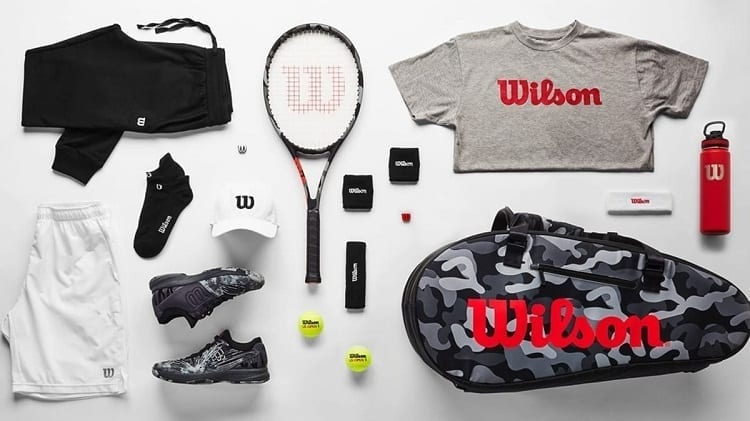
To put it quite simply, there’s a minimum list of items that you just can’t play tennis without. These include:
- Tennis Racket
- Tennis Shoes
- Pressurized Tennis Balls
- Protective Eye Gear / Visor / Hat
Then there are some that you can play without, but your game may be improved if you use them. These include:
- Tennis Ball Machines
- Dampeners
- Overgrips
- Stringing Machines
- Replacement Strings
- Cones
Rackets (or Racquets): What is the Difference?
The name has two different spellings, but there’s no difference between them.
If you spell is racket or racquet, everybody is going to understand what you’re talking about.
A quality racket is going to take your game to the next level by including different string types, higher tension ratings, various materials used in construction, and a ton of minor tweaks that standard rackets just don’t have.
Nobody is out here buying custom rackets; you get the newer year models of your favorite brands and move forward like that.
Quality rackets usually have a much wider selection of grip sizes, as well as various materials for the grip.
There tend to be 6-12 new racket models every year for each brand.
Types of Rackets

There are two main types of rackets that will apply to your specific playing style, physical strength, and your preferences.
As you play more tennis, these attributes will come to the surface and show you a bit about yourself and how you play. Get a racket that suits your style.
Power Racket
Built like behemoths, power rackets typically have a wider head with more square inches of surface space.
The frame is much stiffer and longer, accounting for a bigger player with more muscle control.
The irony is that they’re actually designed to be more lightweight than a control racket for a few different reasons.
It makes them easier to swing, so you’re driving a larger surface area towards the ball.
Once it makes an impact, it absorbs that kinetic energy and propels the ball back to your opponent.
Control Racket
With a slightly shorter build, control rackets are flexible and malleable.
Oddly enough, they’re built a bit heavier than power rackets.
It’s more weight in a smaller package, meaning there’s a little less leverage.
Control rackets are best suited for beginner players or those with a small frame/build who need to increase their hit projection.
Racket Overgrips

Overgrips do just what you’d expect; they go over your current grip.
These make the racket grips a little bit bigger, so it’s preference-based and players with smaller hands may not be able to use them as much.
An overgrip needs a base grip to sort of grasp onto. Without one, it’s not going to stay on the racket properly and you’ll actually have less control of the racket.
Whether or not you want to use these is entirely up to you. Most players use them because they sweat excessively and feel like their racket might slip from their hands. This is a popular overgrip used on the professional tour.
Overgrips are not designed to be your primary grip. They go over the main grip and thus don’t last as long.
While a grip may last a year on your racket, you may outfit your racket with a new overgrip for every match.
Racket Strings

Racket strings are the heart of your racket.
Without proper strings that suit your playing style, you’re going to be left with a fairly basic hitting experience.
Racket strings are made of different materials and they don’t last as long as anyone would like them to.
For light use, you can expect to replace them every six months, but if you’re getting heavy use out of your racket then you might have to restring every two months.
Tension is big here because without the right tension your strings are going to be fairly useless.
Some professional players will string their rackets with up to 70 lbs of tension, whereas the standard racket tension is about 55-65 lbs.
Types of Racket Strings
Synthetic

Synthetic strings are made of multiple sources: nylon, polyester, kevlar, etc.
Any synthetic option is a good one, though nylon tends to be the industry standard.
Nylon will last for a while, aren’t fancy, and will get the job done.
Synthetic strings have one main advantage over natural gut: they’re cheap to replace.
Even if you end up breaking strings 3-4 times per year, it’s still going to be cheaper than buying natural gut strings.
Many pro players use a mix of synthetic and natural gut strings.
Natural Gut
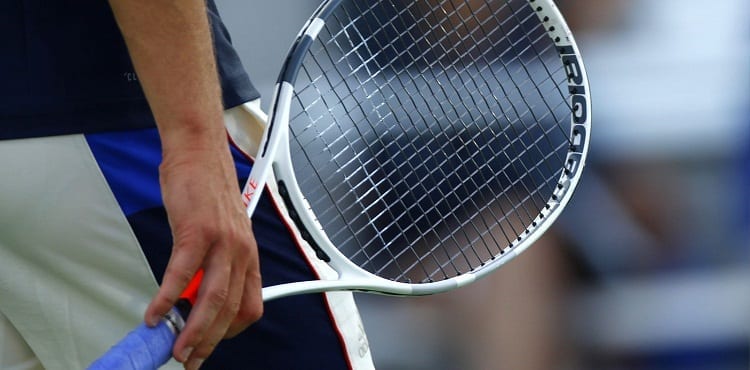
It’s just what it sounds like —strings made from natural gut fibers, usually from cows, that are dried and stretched out to have perfect elasticity.
In medieval times, archers would use this same method to create sinew, which was used in crossbows and longbows for warfare.
Natural gut strings are more expensive than synthetic strings, but they will provide better feel than any synthetic strings that you buy.
Dampeners
Dampeners are little plastic bridges that connect at the cross points in the strings on your racket.
You have to apply them when the racket is already strung.
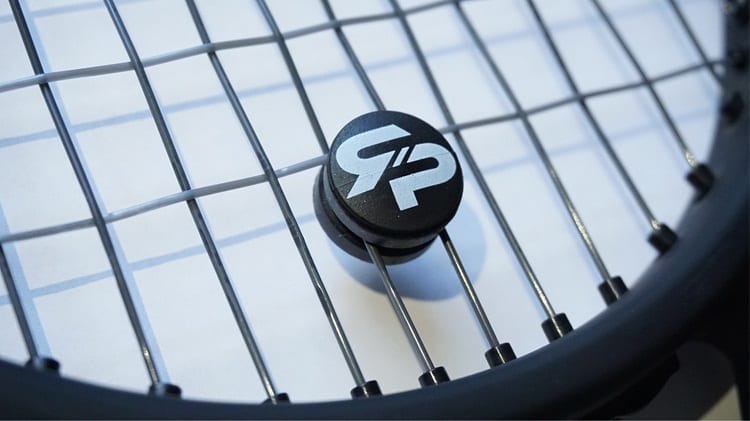
They’re not necessary, but definitely nice and help reduce vibration going up through your hand and arm when you hit.
Dampeners come in multiple material types and are used to eliminate or “dampen” vibrations.
Over time, lots of racket vibrations can lead to tennis elbow. There’s no science that can prove or disprove the use of dampeners helping to alleviate tennis elbow or its symptoms. Personal preference dictates whether or not you’d want to use them.
Why do You Need a Spare Racket?

You’ve got a racket, but to ensure you’re never unable to play, you may also need a spare.
If you’re going into a match, you might run into a serious problem if you break your strings or the racket itself.
You never play more intensely than when you’re up against an opponent instead of a tennis ball machine, and for that, you’re more likely to break the strings.
It takes 45-60 minutes to restring a racket, and that’s if you’re experienced with a stringing machine or near a tennis center where they can drop everything and string your racket..
Nobody has the time to wait around for that… There may be a spare racket for you to use, but people get very protective about who uses their rackets and it wouldn’t be a racket you’re familiar with.
Instead, having a spare at-the-ready will prepare you for this problem.
Whether the strings break or the grip is saturated with your sweat, you don’t want the match to stop short because of equipment failures or malfunctions.
Get a racket bag or a duffel bag that can hold onto two rackets plus your spare tennis balls so you’re never without the necessary equipment.
Even though there’s a perfectly good reason why it might happen, for some reason it feels embarrassing when your racket breaks and you have nothing prepared as a contingency.
Racket Stringing Machines
Racket stringers can be life-savers!
Even with a machine, the process can still take 35 minutes.
The reason they’re necessary is not only to save time or aggravation, but to ensure you have the right tension on your racket.
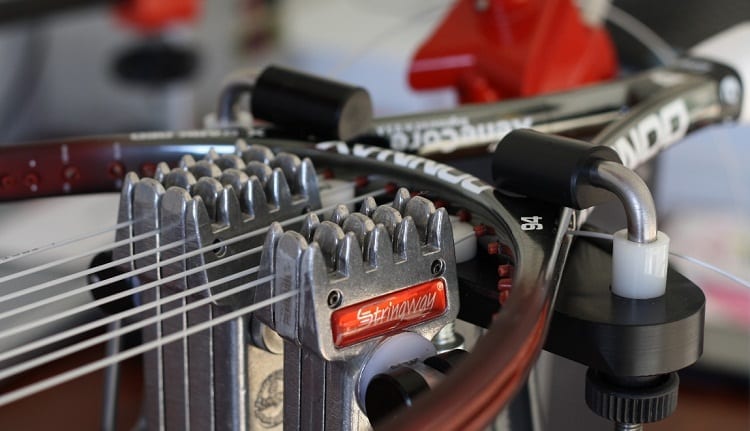
Racket stringers aren’t cheap, even if you get a simple portable unit that fits in your racket sleeve.
They’re an investment, and one that most serious tennis players should definitely consider making.
If you play hard enough that you’re restringing 4-6 times per year, this thing will pay for itself in no time. Professional racket stringing can cost about $30-$50 per racket depending on the materials used.
There are two-point and six-point machines, each with different capabilities.
Six-point machines work the fastest while remaining accurate, so it might only take 35 minutes to string, whereas a two-point system will take 45-50 minutes to string.
Tennis Shoes

Other than a tennis racket, there isn’t another piece of equipment as important as the tennis shoes on your feet.
Being supported for the court surface you’re playing on, comfort, breathability – of the utmost importance when out on the court.
When you’re moving around the tennis court, you can’t be thinking about anything other than getting to the ball.
If you’re focused on your feet because they hurt or you feel like you’re swimming in your shoes, you can’t be all in with your tennis play.
Sports wreak havoc on your joints, no matter what you play, but jumping around on a hard court is arguably near the top of the list for the worst offenders.
Tennis shoes need some of the following attributes to be considered:
Arch Support
Your arch is what takes a lot of the impact, so it’s wise to focus on arch support.
This includes excellent midsoles with vibration absorption capabilities, as well as rubber outsoles that are non-marking (otherwise you’ll pay for damages to a club or public courts), and insoles that add comfort to your stride.
Sock Liners
These might come in your shoes, and if they do, you’re going to be thankful.
Not only do they add a mild arch and overall foot support, but they prevent your feet from turning into stink puddles while you’re playing.
Sock liners are there to wick away sweat and keep everything cool.
Breathability
Mesh uppers and thin tongues are what you’re looking for here.
Shoes with mesh keep your shoes lightweight which is something else you’ll want after a long afternoon on the court.
Weight
Shoes that are too heavy are just going to feel clunky which will prohibit mobility and can mess up your rhythm.
Heavy shoes won’t feel right. Look for a shoe that almost makes you feel like you can glide.
I know it sounds corny, but you don’t want to feel like you have anchors at the end of your ankles.
Do You Need a Different Type of Shoe for Grass, Hard, Indoor, and Clay?
Yes, you should have different shoes for different courts.
You basically have three different court types to look at, each with their own recommendations so that you can retain mobility and reduce shock wherever you play.
Grass Courts
It’s weird but grass is both the most shock-resistant and shock-absorbent material you’ll ever play on.
It’s because it’s natural, whereas clay and concrete have been manipulated to give a consistent feeling.
Grass courts are different than any other court surface and it’s recommended to have tennis shoes with wider bottoms and a special surface that allows you to get a grip on the court and keep your feet planted.
Clay Courts
This is considered to be a premium surface to play on, and it has its quirks.
Clay absorbs shock from your feet and knees, but it mostly affects the ball bounce taking much of the oomph from the shot.
You can have tennis shoes with thin outsoles, insoles, and sides here since you won’t be putting as much stress on them as hard surfaces and occasionally you’ll slide.
Hard Courts
Neither asphalt nor concrete absorb shock like clay or grass.
Everything on this is harder, including the bounce that the ball gives when it comes off the court.
You need plenty of arch support here to cushion your feet from the blow of running around on a hard court.
Tennis Clothing

There’s this whole fashion movement in tennis and it can be exhausting if you try to keep up with the annual trends.
You just need lightweight, breathable clothing that’s not going to get in the way while playing. This usually means wearing:
Shirts
Polo shirts used to be the the go-to, but the tennis scene has relaxed quite a bit over the past few years.
Some private clubs may still require that you wear a collared shirt, but other places won’t restrict what type of shirt you wear.
In hotter weather you’ll want short sleeves. Give moisture wicking a try. You’ll feel so much cooler.
Be mindful of the rules for shirts wherever you’re playing, but be comfortable. Tennis is a sport so sweating will occur!
Shorts/Skirt
It gets hot out here, especially with the way that some tennis matches can carry on for hours.
You’ll be at the mercy of the sun and the length of the match, so get something that airs you out a bit.
Skirts have come a long way with regard to comfort and hidden compartment for keys and such. But many women choose to wear shorts now. Some clubs may allow that while others will insist on women wearing tennis skirts. Know your surroundings and what’s permitted.
For shorts, you want something that’s just above the knees but that also aren’t showing any of your butt.
Like with shirts, wear what’s comfortable and breathable and doesn’t restrict your movement.
Socks
Some people like compression socks, others are just fine with a simple pair of cotton socks, but you need something covering your feet.
I wouldn’t recommend cotton socks though. There’s a saying in the running community of “cotton is rotten” because they don’t allow your feet to breathe and retain a lot of sweat.
Socks aid with comfort and support but also prevents sweat buildup, and thinner tennis shoes that can dig into your ankles. Runners have a lot of sock options. Check these out.
Visor, Hat or Headband

Another preference, but going out on the court without an option to cover your eyes or pool sweat isn’t a great idea.
Headbands help collect sweat during play, and a good visor will do the exact same thing and block the sun from your eyes.
Sunglasses
Much of tennis is played in sunny situations. Sunglasses are optional, but can help to keep your line of sight clear and focused when the sun may be beating down on the court.
Not all tournaments will be accepting of sunglasses, so it’s important to look at the rules beforehand.
Mixing these with a headband will help your visibility while keeping the sweat out of your eyes.
Tennis Bags
Well, you’ve got to get from A to B somehow, and you’ve got plenty of gear to bring along with you.
You don’t need to get a specific tennis bag, but a medium-sized duffel bag will do just fine.
This should contain your tennis gear, shoes, spare strings, spare racket, visor/headband or two, towel, and anything else you find relevant.
Tennis bags are put down on courts, tables and in your car – they don’t really get dirty per se. Even so, you’ll want to find something made out of polyester or nylon that will be as dirt resistant as possible.
Yeah, you’re going to be putting stinky clothes in it, but keeping the outside clean means you’ll look like you’re put-together when you step on the court.
Practice Gear

This covers a wide range, but basically practice gear is anything that you use for practice.
This could range from a beat-up old racket that you can’t get rid of, to some pressurized balls that have lost a bit of their pop, and anything in between.
If you don’t want to fully dress up in tennis clothes for the occasion, your practice gear could be basketball shorts and a loose-fitting t-shirt.
Just be comfortable and able to move so you can do drills and hit serves for as long as you need to.
Tennis Balls
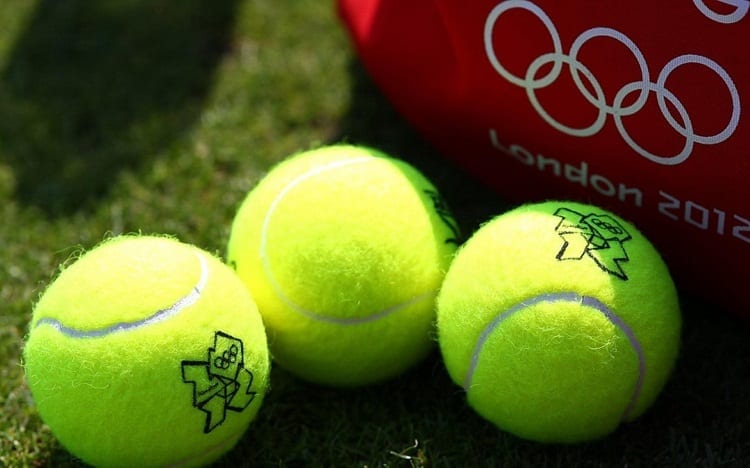
Tennis balls will lose their internal gas and rubber durability over time.
They’re switched out in professional matches on a constant basis (7-9 games depending on if it’s the first ball change) so that they don’t lose their pop and consistency.
It’s also why pros will bounce the ball a few times before serving so they know if there’s any issue or splits in the rubber.
For practice, you can get unpressurized tennis balls to fill your tennis ball machine but those won’t work for matches against opponents.
Most tournaments require pressurized tennis balls to keep everything consistent.
Unpressurized tennis balls or practice balls will last a lot longer than pressurized balls and cost a lot less as well.
Tennis Ball Machines

This is a big one.
If you’re serious about training, and I mean serious, you need one of these for when you don’t have a partner to play with.
Tennis ball machines are far more advanced than the ones you commonly see in reruns of the 1990s comedy movies.
They come with apps, Bluetooth pairing, and remote controls.
One reason you would want a tennis ball machine is to use the variable oscillating modes to test out your abilities and mimic real match play.
They don’t just shoot straight at you; they’ll change based on the number of acceptable degrees of the machinery, and shoot slightly to the left or right.
Tennis ball machines can keep you running up and down the court all day, getting in the same level of workout as if you were up against an opponent.
But much like stringing machines, these are only for those who really want to invest in tennis.
There’s no such thing as a cheap tennis ball machine.
Some have less ball capacity or don’t come with a remote, but that just brings the cost down a very tiny bit.
You’re not going to get away with a cheap one of these.
It’s also not something that’s recommended to buy used.
While some of these are compact, there’s a lot of working parts.
We go into full detail in our tennis ball machine buying guide on why you should avoid buying used ones.
The only time that it’s acceptable is if you’re buying it from a friend and you know for a fact how often and how rigorously it’s been used.
There’s no reason to take a gamble on a used one otherwise.
Cones

Yes, cones. Cones are great for target practice.
Looking to hone your down the T serve? Place a cone at the center mark of the service box and hit away.
Having something specific to target will allow you to focus on hitting your spots.
Wanting to hit with more depth on a consistent basis? Place some cones between the service line and the baseline and try to knock them down.
If you want to run some drills and improve your movement speed and reaction time, getting some cones and weaving through them on the court can make a world of difference in the long run.
You’re Ready to Rule the Court
Now that you know everything you need to about all the different tennis gear on the market, what’s going to stop you from building up your arsenal of tennis gear and absolutely dominating the competition?
Nothing.
Your gear isn’t going to define how good you are, but it certainly is going to make small differences in your comfort and consistency on the court. For more detail on many of the product types listed above, check out our Recommended Gear page!
